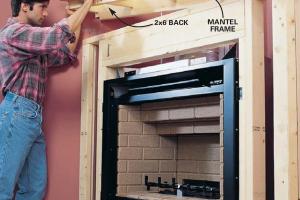Step-by-Step Guide to Installing a Gas Fireplace Like a Pro

-
Quick Links:
- 1. Introduction
- 2. Benefits of Installing a Gas Fireplace
- 3. Types of Gas Fireplaces
- 4. Tools and Materials Needed
- 5. Safety Precautions
- 6. Step-by-Step Installation Process
- 7. Maintenance Tips
- 8. Case Study: Successful Installations
- 9. Expert Insights
- 10. FAQs
1. Introduction
Installing a gas fireplace can be an incredible addition to your home, offering warmth and ambiance. This guide will walk you through the entire process, ensuring that you can install your gas fireplace safely and efficiently.
2. Benefits of Installing a Gas Fireplace
Gas fireplaces have several advantages, including:
- Efficiency: Gas fireplaces heat up quickly and provide consistent warmth.
- Clean Burning: They produce fewer emissions compared to wood-burning fireplaces.
- Convenience: Gas fireplaces require less maintenance and can be turned on/off with a switch.
- Cost-Effective: They are often cheaper to operate than electric heating options.
3. Types of Gas Fireplaces
Before you start the installation, it’s important to understand the different types of gas fireplaces:
- Direct Vent Fireplaces: These units vent directly outside, providing efficient heating without losing indoor air quality.
- Ventless Fireplaces: These units do not require venting and can be installed anywhere, but they should be used with caution due to safety concerns.
- Gas Inserts: These are used to convert traditional wood-burning fireplaces into gas-burning units.
4. Tools and Materials Needed
To install a gas fireplace, you will need the following tools and materials:
- Drill
- Screwdriver
- Level
- Pipe wrenches
- Plumber's tape
- Gas line (flexible or rigid)
- Fireplace unit
- Ventilation kit
5. Safety Precautions
Safety should always be your top priority when dealing with gas appliances. Here are some essential safety tips:
- Always ensure proper ventilation during installation.
- Use gas leak detection solutions to check for leaks.
- Consult local building codes and regulations.
- Consider hiring a licensed professional if you are unsure.
6. Step-by-Step Installation Process
Step 1: Prepare the Site
Choose a suitable location for your gas fireplace. Make sure it is easily accessible for maintenance and complies with local building codes.
Step 2: Install the Venting System
Follow the manufacturer's instructions to install the venting system. Ensure that it is securely attached and meets all local codes.
Step 3: Run the Gas Line
Carefully run the gas line from your main supply to the fireplace location. Use appropriate fittings and connect them securely.
Step 4: Place the Fireplace Unit
Position the fireplace unit in place and ensure it is level. Make necessary adjustments to the venting system as needed.
Step 5: Connect the Gas Supply
Using a pipe wrench, connect the gas supply line to the fireplace. Check for leaks using a gas leak detector.
Step 6: Test the Fireplace
Once everything is connected, turn on the gas supply and test the fireplace. Ensure it ignites and operates smoothly.
7. Maintenance Tips
To ensure your gas fireplace operates efficiently, regular maintenance is key:
- Clean the glass front regularly.
- Inspect the venting system for any blockages.
- Check the gas line and connections for any leaks.
- Schedule annual maintenance with a professional.
8. Case Study: Successful Installations
In 2022, the Johnson family replaced their old wood-burning fireplace with a gas insert. They reported a 30% reduction in heating costs and appreciated the ease of use during winter months. Their installation took about 6 hours, and they highlighted the importance of professional assistance for certain steps.
9. Expert Insights
According to John Smith, a certified heating technician, “Proper installation is crucial for the safety and efficiency of any gas appliance. Always follow local codes and seek professional help if necessary.”
10. FAQs
1. Can I install a gas fireplace myself?
While it is possible, it is recommended to hire a professional to ensure safety and compliance with local codes.
2. How long does it take to install a gas fireplace?
The installation process typically takes between 4 to 8 hours, depending on the complexity of the installation.
3. What are the costs associated with installing a gas fireplace?
Costs can vary widely, typically ranging from $2,000 to $5,000 including materials and labor.
4. Do I need a permit to install a gas fireplace?
Yes, most municipalities require a permit for gas fireplace installations. Always check with your local regulations.
5. Are gas fireplaces safe?
When installed correctly, gas fireplaces are safe. Regular maintenance is essential to ensure their safe operation.
6. Can I use a gas fireplace during a power outage?
Yes, most gas fireplaces can operate without electricity, making them a reliable heating source during outages.
7. How do I clean my gas fireplace?
Regularly clean the glass front and check the burner for any debris. A professional cleaning service can also be helpful.
8. What should I do if I smell gas?
If you smell gas, immediately turn off the gas supply, evacuate the area, and contact a professional technician.
9. How often should I have my gas fireplace inspected?
It’s recommended to have your gas fireplace inspected annually to ensure it operates safely and efficiently.
10. Are ventless gas fireplaces legal?
Ventless gas fireplaces are legal in some areas, but restrictions may apply. Always check your local regulations.
Random Reads